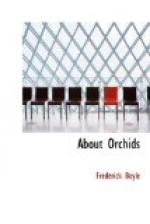Warm orchids come from a sub-tropic region, or from the mountains of a hotter climate, where their kinsfolk dwelling in the plains defy the thermometer; just as in sub-tropic lands warm species occupy the lowlands, while the heights furnish Odontoglossums and such lovers of a chilly atmosphere. There are, however, some warm Odontoglossums, notable among them O. vexillarium, which botanists class with the Miltonias. This species is very fashionable, and I give it the place of honour; but not, in my own view, for its personal merits. The name is so singularly appropriate that one would like to hear the inventor’s reasons for transfiguring it. Vexillum we know, and vexillarius, but vexillarium goes beyond my Latin. However, it is an intelligible word, and those acquainted with the appearance of “regimental colours” in Old Rome perceive its fitness at a glance. The flat bloom seems to hang suspended from its centre, just as the vexillum figures in bas-relief—on the Arch of Antoninus, for example. To my mind the colouring is insipid, as a rule, and the general effect stark—fashion in orchids, as in other things, has little reference to taste. I repeat with emphasis, as a rule, for some priceless specimens are no less than astounding in their blaze of colour, the quintessence of a million uninteresting blooms. The poorest of these plants have merit, no doubt, for those who can accommodate giants. They grow fast and big. There are specimens in this country a yard across, which display a hundred and fifty or two hundred flowers open at the same time for months. A superb show they make, rising over the pale sea-green foliage, four spikes perhaps from a single bulb. But this is a beauty of general effect, which must not be analyzed, as I think.
Odontoglossum vexillarium is brought from Colombia. There are two forms: the one—small, evenly red, flowering in autumn—was discovered by Frank Klaboch, nephew to the famous Roezl, on the Dagua River, in Antioquia. For eight years he persisted in despatching small quantities to Europe, though every plant died; at length a safer method of transmission was found, but simultaneously poor Klaboch himself succumbed. It is an awful country—perhaps the wettest under the sun. Though a favourite hunting-ground of collectors now—for Cattleyas of value come from hence, besides this precious Odontoglot—there are still no means of transport, saving Indians and canoes. O. vexillarium would not be thought costly if buyers knew how rare it is, how expensive to get, and how terribly difficult to bring home. Forty thousand pieces were despatched to Mr. Sander in one consignment—he hugged himself with delight when three thousand proved to have some trace of vitality.




